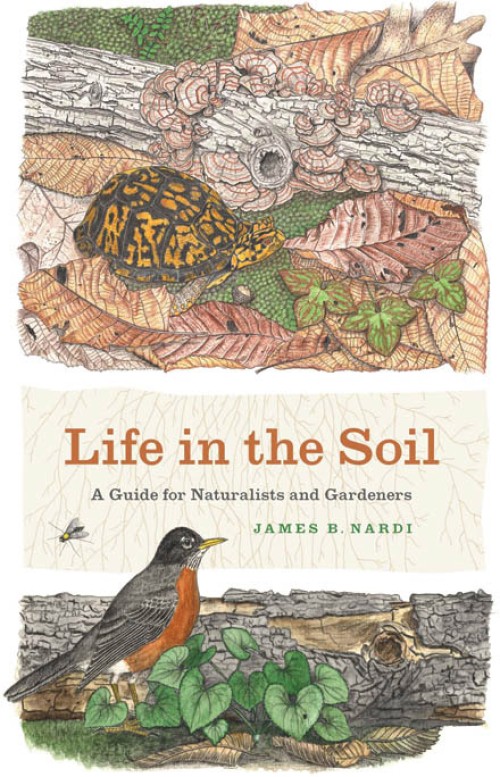by James B. Nardi
The University of Chicago Press, 2007
After reading this book, you might find yourself having a panic attack the next time you press a spade into topsoil.
There are myriad creatures– many are bizarre and many are beautiful – who call that spadeful of dirt “home.” Soil is an amazingly busy place, and although many of its inhabitants are on a microscopic scale, their importance to life on earth is enormous. It turns out that they are really interesting as well.
The book begins with the creation of substrate, wherein parent materials, as rocks are called, are transformed into silt, clay, or sand by being heated, cooled, frozen, and deluged with carbonic acid, a natural ingredient of rainfall. That’s all essential, but the author is most inspired by the accomplishments of living organisms, beginning with the patient lichens that can live for more than a thousand years, secreting acids that can eat into any rock, even granite.
Life in the Soil does indeed bring soil to life. The presentation is in a modified field guide format, with each group of soil dwellers considered separately, but the storyline explains how the actions of each group contribute to the formation of humus, the key to healthy soil. Only humus can latch on to nutrients and keep them within easy reach of plant roots as the nutrients move back and forth from the living to the non-living world.
Decomposers, shredders, and diggers all have their roles, but bacteria are the true heroes of the story as only they can liberate the essential elements from soil in forms that living plants can use. Other microbes, including actinomycetes, slime molds, algae, fungi, protozoa, and a hodgepodge of other microscopic beings are also present. Many of them occur in quantities that make our national debt seem manageable: imagine 10 billion protozoa in the top 15 centimeters of just a square meter of soil, not to mention the billions of bacteria and other life forms coexisting in the same space.
The shapes and behaviors needed to survive in soil are unlike those required for a happy existence in air or water, and these are nicely pointed out for each group of animals. Different springtails (snow fleas are one of the roughly 7,500 springtail species) inhabit different layers of the soil – becoming paler and shortertailed in the lower layers. The deepest dwelling springtails have no tail and no eyes. Myriapods have more than seven pairs of legs and are common underground. They are not built for speed but instead are able to twist and turn through tight spaces. Many underground insects have small wings or no wings. Although mole crickets have been redesigned, they haven’t given up chirping; instead they mold underground chambers that look and sound like a megaphone. In addition, they have velvety fur that sheds water and mud, and front legs shaped for digging.
Most of the creatures Nardi describes are within reach of our shovels in the Northeast, but he slips in tales of the underground activities of such animals as the motmot, wombat, and spiny anteater to liven things up. And even though we won’t find them – nor will we find onchophorans, ricinuleids, or caecilians – all of these animals demonstrate the enormous diversity of underground life. Plus, the author’s drawings of these – and all the other organisms – are lovely. Not everyone can make a long-legged orabatid mite with a pile of shed skins on its back look adorable, but Nardi’s illustration does just that.


